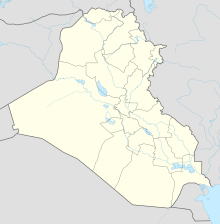Jarmo
Coordinates: 35 ° 32 '20.9 " N , 44 ° 55' 49.1" E
Jarmo also Qal'at Jarmo or Jarmo ( Sulaimaniya province , Tschamtschamal district ) is an archaeological site in northern Iraq at the foothills of the Zāgros Mountains east of the city of Kirkuk . The place is known as the oldest agricultural community in the world and is about 9,000 years old. Jarmo is about the same age as the Neolithic Jericho in the southern Levant and older than Çatalhöyük in Anatolia . Jarmo is about 12,000 to 16,000 square meters and is located at an altitude of 740 meters, formerly in a belt of oak and pistachio forests.
Discovery and excavation
The place was discovered in 1940 by the Iraqi Directorate of Antiquities and later excavated by the American archaeologist Robert John Braidwood (1907-2003) of the University of Chicago Oriental Institute , who researched the Neolithic Revolution . Braidwood worked in cooperation with the Iraqis for three excavation campaigns (1948, 1950–1951, 1954–1955) to investigate the site. A fourth excavation campaign from 1958 to 1959 did not take place because of the revolution and the overthrow of the Iraqi King Faisal II. In 1958, Braidwood left the cuts unfilled. Braidwood later turned to excavations at Tepe Asyab in Iran and moved to Turkey in 1963 because of difficulties there .
New archaeological methods
In the Jarmo excavations from 1954 to 1955, Braidwood first used a multidisciplinary approach in an attempt to refine the investigation methods and specify the origin of the domestication of plants and animals. His team included geologist Herbert Wright, paleobotanist Hans Helbaek , ceramic and radiocarbon dating expert Frederic Mason, zoologist Charles Reed, and a number of other archaeologists and anthropologists. Frank Hole was responsible for the recordings of the flint devices. The interdisciplinary method was then used by other teams in the archaeological fieldwork.
The village of Jarmo
The excavations revealed a small village with an area of 12,000 to 16,000 square meters and twelve layers. With radiocarbon dating , the age of the oldest stratum was dated to 7090 BC. And the youngest to 4950 BC. Chr. Determined. It appears that Jarmo consisted of two permanent settlements. These coincided with Jericho and the Neolithic phase of Shanidar . The peak of Jarmos is likely between 6200 and 5800 BC. Have been.
This small village consisted of little more than 25 houses with a simple floor plan, with sun-dried mud roofs and Stampflehmwänden which rested on stone foundations. These apartments were often repaired or rebuilt. In total, about 150 people lived in the village, which was clearly a permanent settlement.
In the earlier phases there is a predominance of objects made of stone, flint and obsidian . The use of obsidian, which originated from Lake Van 320 kilometers away , shows that some form of organized trade already existed, as well as the presence of ornate shells from the Persian Gulf . Baskets impregnated with pitch were found in the oldest building layer . Bad luck is easily available in the area. Imprints of baskets and textiles were also found.
Agriculture and ranching
Agriculture in Jarmo was documented by the discovery of stone sickles and millstones. These objects were suitable for harvesting and processing food. In addition, engraved marble vessels were found. In the later phases implements made of bones, especially awls, buttons and spoons were found.
The residents of Jarmo planted two types of wheat, emmer and einkorn , primitive barley and lentils . They and their animals also consumed wild plants such as peas , acorns , carob seeds , pistachios, and wild wheat. Snail shells are also abundant. There is evidence that goats , sheep and dogs were domesticated. Pig bones, which Price and Arbuckle attribute to domesticated animals, have already been found in the ceramic layers . If this analysis, based on a very small sample, proves to be true, it would be the earliest evidence of pig farming in the Zagros.
Pottery and religion
Jarmo is one of the oldest places where pottery was found. It appears in the last layers from the 7th millennium BC. This ceramics is simple in execution, with thick walls and vegetable lean . In addition, zoomorphic and anthropomorphic clay figures were found. Clay figures of pregnant women are interpreted as portraits of fertility goddesses . Such mother goddesses are known from the region from the late Neolithic.
literature
- Robert J. Braidwood: Letters from the Field, 1950-1951. Excavations at Jarmo. In: The Oriental Institute News and Notes. No. 156, 1998.
- Linda S. Braidwood, Robert J. Braidwood, CA Reed, Polly J. Watson (Eds.): Prehistoric Archeology along the Zagros Flanks. (PDF; 73.0 MB). (= The Oriental Institute Publications. 105). Chicago 1983, ISBN 0-918986-36-2 .
- MD Price, BS Arbuckle: Early Pig Management in the Zagros Flanks: Reanalysis of the Fauna from Neolithic Jarmo, Northern Iraq. In: International Journal of Osteoarchaeology. 2013. doi: 10.1002 / oa.2312
Individual evidence
- ↑ The Jarmo Chipped Stone. In: Linda S. Braidwood, Robert J. Braidwood, CA Reed, Polly J. Watson (Eds.): Prehistoric Archeology along the Zagros Flanks. (PDF; 73.0 MB) (= Oriental Institute Publications. 105). Chicago 1983, pp. 233-288.
- ↑ JM Adovasio: The textile and basketry impressions from Jarmo. In: Palèorient. 3, 1977, pp. 223-230; JM Adovasio: Notes on the textile and basketry impressions from Jarmo. In: Linda S. Braidwood et al. (Ed.): Prehistoric Archeology along the Zagros Flanks. (= Oriental Institute Publications. 105). Oriental Institute of the University of Chicago, Chicago 1983, pp. 425-427.
- ↑ a b M. D. Price, BS Arbuckle: Early Pig Management in the Zagros Flanks: Reanalysis of the Fauna from Neolithic Jarmo, Northern Iraq. In: International Journal of Osteoarchaeology. 2013.

